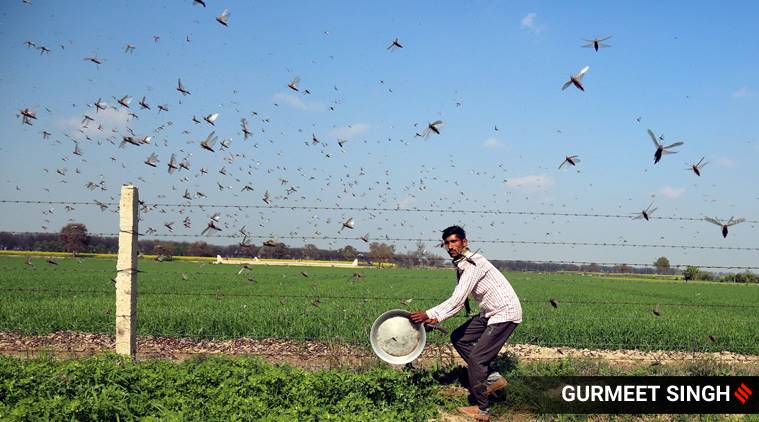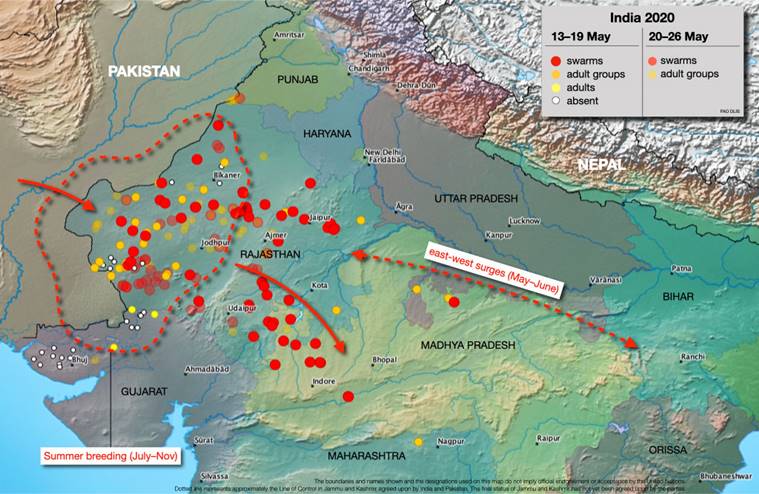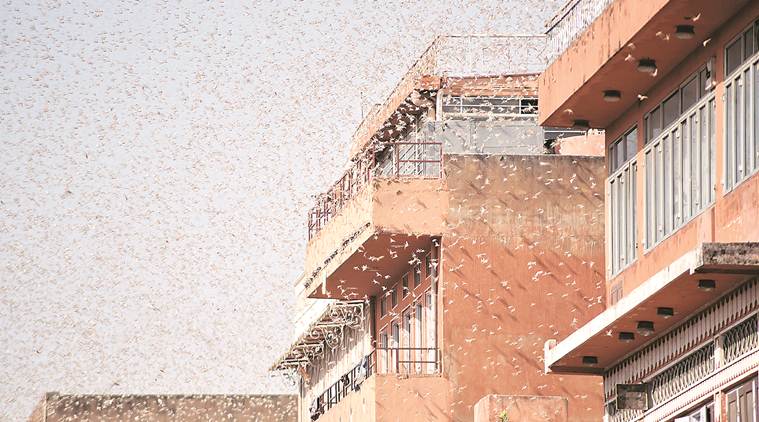
The Indian Express
Locust attack tracker: Where the hoppers are headed and how states are preparing for battle
Locust Attack in India, Locust Swarm Tracker: With India battling the worst desert locust outbreak in three decades, the crop-destroying insects have now spread to Punjab, Gujarat, Maharashtra and Madhya Pradesh after arriving in Rajasthan.
by Express Web DeskLocust attack tracker: At a time when India is grappling with Covid-19, a locust crisis is swarming over northern parts of the country, with several states issuing advisories to prevent a desert locust attack. With India battling the worst desert locust outbreak in three decades, the crop-destroying insects have now spread to Punjab, Gujarat, Maharashtra and Madhya Pradesh after arriving in Rajasthan.
In its latest update, the United Nations’s Food and Agriculture Organisation (FAO) desert locust information center said much of these movements were associated with strong westerly winds from the Bay of Bengal.
“Several successive wave of invasions could be expected till July in Rajasthan with eastward surges across northern India as far as Bihar and Orissa followed by westward movements and a return to Rajasthan on the changing winds associated with the monsoon. These movements will cease as swarms begin to breed and become less mobile. Swarms are less likely to reach south India,” the UN body said in its latest update.
According to the Locust Warning Organisation (LWO), which monitors locust swarms, there is no immediate danger of the swarms heading towards Delhi. The insects feed on a large variety of crops. If not controlled, locust swarms can threaten the food security of a country.

Locust attack tracker: Here are the advisories issued by states
👉 Delhi
In its advisory, the Delhi government has listed measures like taking steps to ensure the locusts are not allowed to rest and organising awareness campaigns for the general public and farmers on the attack. “As the swarm usually fly in the day time, the locust should not be allowed to rest at night,” the advisory read.
The circular also listed four chemicals — Melathion 50% EC, Melathion 25% WP, Chloropyriphos 20% EC and Chloropyriphos 50% EC — that must be diluted in water and used as pesticides and sprayed in the evening to control the swarm.
Express Research | As the locusts fly in, memories, and fears, of a recurring ‘plague’
Also, Delhi’s forest department is considering covering the saplings in its nurseries with polythene to protect them against the desert locust attack. There are 14 lakh saplings in 14 government nurseries across Delhi.
“Covering plants with polythene can also counter-productive during this heat. So, we will do this only when we know for sure that the swarm of locusts is headed towards Delhi,” PTI quoted Principal Chief Conservator of Forests Ishwar Singh as saying.

👉 Uttar Pradesh
In Uttar Pradesh, overnight operations were carried out by the authorities to clear swarms of locusts in Moth and Garautha areas of Jhansi, and in Sonbhadra district. Two fire brigade vehicles loaded with insecticide have been deployed in all four Jhansi tehsils besides six vehicles have been kept ready at the district headquarter. Ten municipal employees with two insecticide spraying machines were posted in every block.
“An advisory has been issued that in case there is an attack by locusts, people should gather at a place and bang dhols, drums, tin boxes and thalis, and create noise,” read a statement issued by the state government on Wednesday.
At the state-level, teams have already been formed and control rooms established to track the movement of locusts. At the district headquarter level, a nodal officer has been appointed, and a task force and control room already set up. Officials have been instructed to list elaborate details of the danger posed by locusts and precautions that need to be taken.

👉 Punjab
All Punjab districts have been put on alert and control rooms have been set up in each district and farmers have been asked to report any activity of locusts. For the time being, an amount of Rs 1 crore has been allocated for controlling the locust attacks.
As per the Agriculture department, officers have been asked to maintain strict vigil in their respective areas. Surveys will be conducted, especially in areas bordering Pakistan and Rajasthan. Spray pumps will also be made available by the agriculture department to villagers to effectively contain any locust attack, the advisory said.
👉 Haryana
Haryana has issued a high alert in seven districts and tractors mounted with chemical sprayers have also been deployed to thwart desert locust attack. The districts which are on high alert are Sirsa, Fatehabad, Hisar, Bhiwani, Charkhi Dadri, Mahendragarh and Rewari.
“We have stocked enough pesticides; insecticides and we have also formed farmers’ group. We have also formed farmers’ group even on WhatsApp,” Additional Chief Secretary, Agriculture and Farmers Welfare Department, Sanjeev Kaushal told PTI.
A response team headed by senior agriculture department officer Surinder Singh Dahiya has been formed to coordinate with the deputy commissioners.
Explained
Why we have a desert locust problem this year
Large-scale breeding and swarm formation takes place only when conditions turn very favourable in their natural habitat, i.e. desert and semi-arid regions. These areas should get rains that will produce enough green vegetation to enable both egg laying and hopper development. It appears that such conditions have been there since the start of this year. The main locust breeding areas in the Horn of Africa, Yemen, Oman, Southern Iran and Pakistan’s Baluchistan and Khyber Pakhtunkhwa provinces recorded widespread rains in March-April. East Africa, in fact, had its wettest rainfall season in over four decades even during October-November. The hopper bands and immature adult groups resulting from this large-scale breeding – itself a product of unusually heavy rains – are the ones that started arriving in Rajasthan during the first fortnight of April.
👉 Rajasthan
One of the worst-hit states, about 90,000 hectares in 20 districts of Rajasthan have been affected due to the locust attack, PTI reported.
On locust control operations, Commissioner of the Agriculture Department said said 800 tractors with mounted sprayers were being used to neutralise locusts. About 200 teams are involved in daily survey and farmers are being given free pesticides.
👉 Maharashtra
With swarms of locusts currently moving in Vidarbha region of Maharashtra, the administration has issued a slew of directives to tackle attack on crops by the insects. Farmers in Palghar district have been asked to remain guarded against the locusts in order to save their standing crops.
“Precautionary measures should be taken to prevent damage from locusts. The villagers should monitor and inspect the fields at night in groups. Between 7 pm and 9 pm, millions of these insects can land in the fields to rest,” the advisory said.
Large ditches should be dug and loud music should be played. The advisory also recommended the use of insecticide and neem-based spray on the crops to save them from damage. Spraying should be done late at night or early in the morning if possible.